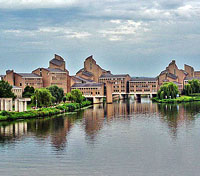Even though Armenia became a member of different European institutions shortly after getting independence, still our society does not have a clear understanding of the united Europe. It is observed in information field as well: there are people who still don’t know what the difference between the Euro Union and European commission is. This fact results in lack of a clear understanding of the mentioned European institutions, thus the role of Europe as one unit. Accordingly, we will bring some information on the structure and main activities of the Euro Union.
The European Union is a specific economic and political cooperation, which unites European 27 democratic states. These are the countries, which have signed the agreement on European Union (the Maastricht agreement). The European Union is an international organization with specific characteristics of an international organization and state. However, formally the EU’s structure is neither of the mentioned ones. The starting point of the European integration process is considered the resolution of French foreign affairs minister Robert Schuman (May 9, 1950), which suggested to establish the European coal and iron community (ECIU). The founding agreement of this institution was signed by the following six countries: France, the Federal Republic of Germany, Belgium, the Netherlands, Luxemburg and Italy. The mentioned document was signed on April 18, 1951. This is considered to be the first phase of the establishment of the incumbent European Union. The integration of coal and metallurgy opened a new way for the other fields of the economy and integration, as a result of which on March 25, 1957, the ECIU countries signed the agreement of setting up the European Economic Community (EEC) and the European Atomic Energy Community. The biggest role in setting up and developing the mentioned three institutions vested in the EEC, the main goal of which was the foundation of a customs union and common market to provide free movement of people, goods, capital and services in the member countries. The countries having signed the agreement took the responsibility to harmonize their economic policies and legislations. Throughout the development of the EEC other countries joined this institution as the following: the Great Britain, Denmark and Ireland in 1973, Greece in 1981, Spain and Portugal in 1986, Austria, Finland and Sweden in 1995, Hungary, Cyprus, Latvia, Lithuania, Malta, Poland, Slovakia, Slovenia, Czeck and Estonia in 2004, Bulgary and Romania in 2007.
In fact, the process of the EEC formation proceeded in several phases.
1957-1968. Formation of the free trade zone. Customs fees, quotas and other limitations between the member states were raised.
1968-1987. Customs union. Common customs regime and trade policy in relations to relationships with third countries.
1987-1992. Common inner market. Free movement of labor, capital and services.
1992-2002. Economic and currency unity. Common monetary policy and common currency (Euro).
During the European community enlargement process, on February 7, 1992, an important document was signed in Maastricht city of Holland, which was the beginning of the European Union.
Currently the EU is in a process of reformation too. On the one hand the EU is improving the economic cooperation mechanisms with the EU and neighboring countries, on the other hand it is improving the so-called political system of the EU, specifically the European Constitution. The treaty establishing a Constitution for Europe was signed in Rome on October 20, 2004. However currently the adoption of the European Constitution depends on the agreement signed in Lisbon on December 13, 2007, which is the simple version of the first document. The adoption of the European Constitution is still in process and we will bring details about this process in our future publications of the European Window.
This supplement has been produced with the assistance of the European Union. The content of this supplement is the sole responsibility of “168 Hours” Newspaper and can in no way be taken to reflect the views of the European Union

